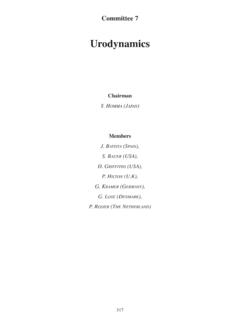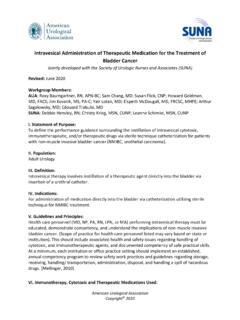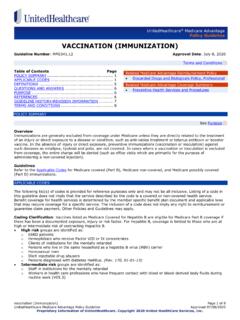Transcription of DRUG NAME: Oxaliplatin
1 Oxaliplatin DRUG NAME: Oxaliplatin SYNONYM(S): ACT-078, l-OHP, LOHP, oxalatoplatin, oxaliplatinum COMMON TRADE NAME(S): ELOXATIN CLASSIFICATION: Alkylating agent Special pediatric considerations are noted when applicable, otherwise adult provisions apply. MECHANISM OF ACTION: Oxaliplatin belongs to a new class of platinum agent. It contains a platinum atom complexed with oxalate and diaminocyclohexane (DACH). The bulky DACH is thought to contribute greater cytotoxicity than cisplatin and The exact mechanism of action of Oxaliplatin is not known. Oxaliplatin forms reactive platinum complexes which are believed to inhibit DNA synthesis by forming interstrand and intrastrand cross-linking of DNA molecules. Oxaliplatin is not generally cross-resistant to cisplatin or carboplatin, possibly due to the DACH group and resistance to DNA mismatch ,2 Preclinical studies have shown Oxaliplatin to be synergistic with fluorouracil and SN-38, the active metabolite of Oxaliplatin is a radiation-sensitizing ,5 It is cell cycle PHARMACOKINETICS: Interpatient variability inter- and intra-subject variability is low6 Distribution minimal in plasma; accumulation in erythrocytes does not diffuse into plasma or act as a drug reservoir cross blood brain barrier?
2 No information found volume of distribution ultrafilterable platinum*: 582 261 L6 plasma protein binding 70-95% Metabolism rapid nonenzymatic biotransformation to reactive platinum complexes7 active metabolite(s) DACH platinum species6 inactive metabolite(s) several conjugates,6 including the 1,2-DACH-platinum dichloride (2%) associated with neurotoxicity3 Excretion platinum is mainly by renal excretion and tissue distribution,8 while platinum metabolites are mainly by renal excretion1 urine 50% within 3 days9 feces minimal9 terminal half life ultrafilterable platinum*: 273 19 h6 platinum elimination from erythrocytes: 48 days1 clearance ultrafilterable platinum*: L/h6 Adapted from reference1 unless specified otherwise. Ultrafilterable platinum consists of Oxaliplatin and free Oxaliplatin metabolites.
3 BC Cancer Agency Cancer Drug Manual Page 1 of 9 Oxaliplatin Developed: 2001 Revised: 1 December 2016 Oxaliplatin USES: Primary uses: Other uses: *Colorectal cancer10-12 Breast cancer13 Gastric cancer14 Germ cell cancer15 Head and neck cancer16 Lung cancer, non-small cell17 Lymphoma, non-Hodgkin s18 Mesothelioma19,20 Ovarian cancer21,22 Pancreatic cancer23 Prostate cancer24 *Health Canada Therapeutic Products Programme approved indication No pediatric indications. SPECIAL PRECAUTIONS: Contraindications: history of hypersensitivity reaction to Oxaliplatin or other platinum agents (eg, cisplatin, carboplatin)6 peripheral sensory neuropathy interfering with function or severe renal dysfunction (CrCl < 30 mL/min)6 Caution: QT prolongation and torsades de pointes are reported; use caution in patients with history of QT prolongation or cardiac disease and those receiving concurrent therapy with other QT prolonging medications.
4 Correct electrolyte disturbances prior to treatment and monitor ,26 Special populations: Elderly patients over 65 may be at higher risk of severe (grades 3-4) Women may be at higher risk of severe (grades 3-4) Carcinogenicity: Oxaliplatin is considered a probable carcinogen, although carcinogenic studies have not been Mutagenicity: Mutagenic in mammalian in vitro mutation chromosome Fertility: no information found Pregnancy: Oxaliplatin produced embryo-fetal toxicity in Breastfeeding is not recommended due to the potential secretion into breast SIDE EFFECTS: The table includes adverse events that presented during drug treatment but may not necessarily have a causal relationship with the drug. Because clinical trials are conducted under very specific conditions, the adverse event rates observed may not reflect the rates observed in clinical practice.
5 Adverse events are generally included if they were reported in more than 1% of patients in the product monograph or pivotal trials, and/or determined to be clinically important. Incidence of adverse events is generally similar when Oxaliplatin is used as a single agent or in combination with fluorouracil and leucovorin, although severe (grades 3-4) diarrhea, nausea and vomiting, and neurotoxicity are more common with combination ,27 BC Cancer Agency Cancer Drug Manual Page 2 of 9 Oxaliplatin Developed: 2001 Revised: 1 December 2016 Oxaliplatin ORGAN SITE SIDE EFFECT Clinically important side effects are in bold, italics allergy/immunology anaphylaxis ( )6,28,29 blood/bone marrow febrile neutropenia anemia (64-83%, severe 4-5%) febrile neutropenia (< 2%) immune hemolytic anemia (rare)30 neutropenia: single agent (15%, severe 3%); with fluorouracil and leucovorin (66%, severe 38%) thrombocytopenia: single agent (41%, severe 3%).
6 With fluorouracil and leucovorin (76%, severe 4%) constitutional symptoms fever (36%) dermatology/skin extravasation hazard: irritant31-36; treat as vesicant37; see paragraph following Side Effects table alopecia (2%) gastrointestinal emetogenic potential: high moderate38 diarrhea: single agent (41%, severe 5%); with fluorouracil and leucovorin (58%, severe 10%) mucositis: single agent (4%, severe 2%); with fluorouracil and leucovorin (42%, severe 8%) nausea, vomiting (69-71%, severe 12-14%) hepatic liver function abnormalities (46%, severe 12%) infection infection (23%) investigations QT prolongation, torsades de pointes25,26,39,40 neurology central neurotoxicity/reversible posterior leukoencephalopathy syndrome (<1%)41-45; see paragraph following Side Effects table neuropathy, sensory (85-95%); see paragraph following Side Effects table pharyngolaryngeal dysesthesia (1-2%); see paragraph following Side Effects table renal/genitourinary renal dysfunction (3%, severe < 1%) vascular thromboembolic events, including deep vein thrombosis46 (1-10%)46-48 Adapted from reference6 unless otherwise specified.
7 Peripheral sensory neuropathy is cumulative, dose-related and usually reversible a few months after stopping treatment. Symptoms include sensory ataxia and dysesthesia of the limbs, mouth, throat and larynx, and may be exacerbated by exposure to cold (eg, touching cold surface, drinking cold liquid).1,38 The incidence of grade 2 neuropathy is 10% after 3 treatment cycles and 50% after 10 cycles. Grade 3 neuropathy occurs in 10% after 9 cycles and 50% after 14 cycles, is reversible in 74% of the cases, and begins to recover after 13 weeks. Paresthesia interfering with function (eg, buttoning clothing, holding objects, writing) is seen in 16% of patients after 4 months of treatment and rarely leads to Oxaliplatin Unlike cisplatin, Oxaliplatin neuropathy is related to injury to small rather than large sensory The use of calcium gluconate or magnesium sulfate infusions pre- and/or post Oxaliplatin treatment do not appear to reduce or protect against Oxaliplatin -induced Gabapentin PO 100 mg twice daily, with increments of 100 mg PO daily as needed, may be effective in some patients to reduce Oxaliplatin neuropathy,53 while carbamazepine does not appear to be Other agents used with some success include alpha-lipoic acid IV 600 mg weekly for 3-5 weeks, then followed by oral 600 mg three times Oxaliplatin delivered according to 24-hour biologic rhythms (chronomodulated)
8 Appears to be associated with less peripheral neuropathy than fixed rate ,12 Pharyngolaryngeal dysesthesia with sporadic reduced sensitivity of the larynx and pharynx is seen in 1-2% of patients shortly after drug infusion. Symptoms usually resolve within hours of onset but the feeling of difficulty in breathing or swallowing may be distressing to the patient. Treatment is usually not needed, BC Cancer Agency Cancer Drug Manual Page 3 of 9 Oxaliplatin Developed: 2001 Revised: 1 December 2016 Oxaliplatin although antihistamines and bronchodilators have been used. To prevent recurrence, infusion time should be extended to 6 hours with subsequent ,6 Reversible posterior leukoencephalopathy syndrome (RPLS; also known as PRES) has been associated with Oxaliplatin ,41-45 which may cause endothelial dysfunction and lead to vasogenic ,43 Clinical presentation includes altered mental status, seizures, headache, and loss of vision with associated radiographic abnormality on MRI or Symptom onset may be delayed relative to treatment, with cases reported 8 to 12 days after the first infusion and as long as 6 weeks post ,44,56 Management is usually supportive, with control of hypertension, electrolyte replacement, seizure management, and discontinuation of ,43 Although usually reversible, permanent disability and fatalities have been ,43 Management of extravasation.
9 Extravasation of Oxaliplatin may sometimes cause severe local inflammation and potentially tissue The optimal non-pharmacological management of Oxaliplatin extravasation is unclear. However, it has been suggested that warm compresses may be preferred over cool compresses33,57,58 which may theoretically precipitate or worsen peripheral sensory neuropathy. For management of extravasation reactions, see BCCA Policy Number III-20 Prevention and Management of Extravasation of Chemotherapy. INTERACTIONS: AGENT EFFECT MECHANISM MANAGEMENT fluorouracil59 no influence on fluorouracil pharmacokinetics irinotecan60-62 induction of irinotecan-related cholinergic syndrome may potentiate irinotecan inhibition of acetylcholinesterase give prophylactic atropine before irinotecan topotecan63 no effects on topotecan pharmacokinetics warfarin64 significantly higher incidence of INR elevation when administered with Oxaliplatin /fluorouracil based regimens unknown; possible synergy of anticoagulant effect of fluorouracil by Oxaliplatin for Oxaliplatin /fluorouracil based regimens only: monitor INR regularly during and for one month following completion of treatment.
10 Adjust warfarin dose as needed Avoid concurrent use of QT/QTc-prolonging drugs if possible. Use caution with drugs that may disrupt electrolyte levels. Correct electrolytes as needed and monitor as SUPPLY AND STORAGE: Injection: sanofi-aventis Canada Inc. supplies Oxaliplatin as 50 mg and 100 mg single-use vials of sterile lyophilized powder and 50 mg, 100 mg, and 200 mg single-use vials of sterile preservative-free aqueous solution in a concentration of 5 mg/mL. Store at room temperature. Do not freeze. Protect from light for long-term Sandoz Canada Inc. supplies Oxaliplatin as 50 mg, 100 mg, 150 mg, and 200 mg single-use vials of preservative-free aqueous solution in a concentration of 5 mg/mL. Store at room temperature. Do not freeze. Protect from For basic information on the current brand used at the BC Cancer Agency, see Chemotherapy Preparation and Stability Chart in Appendix.















